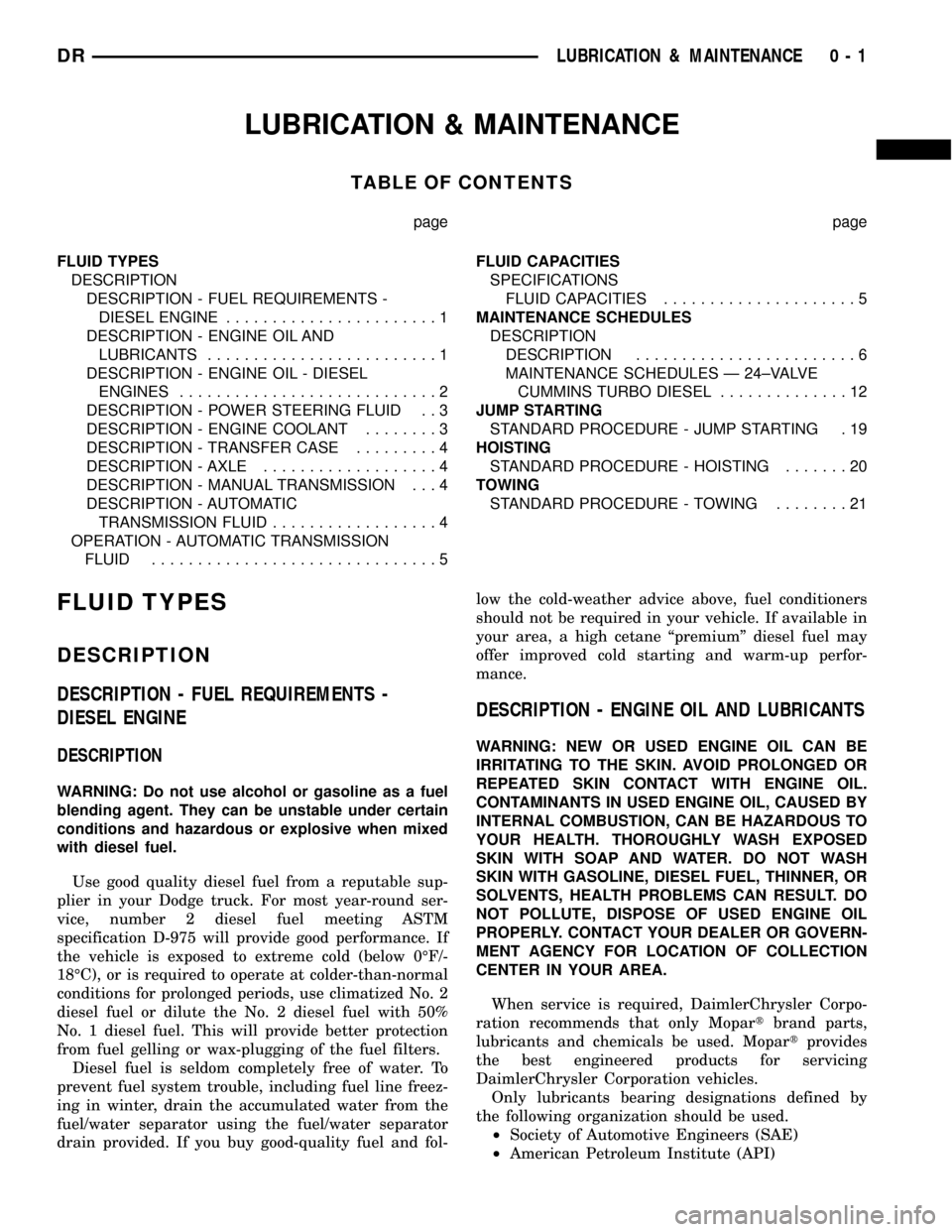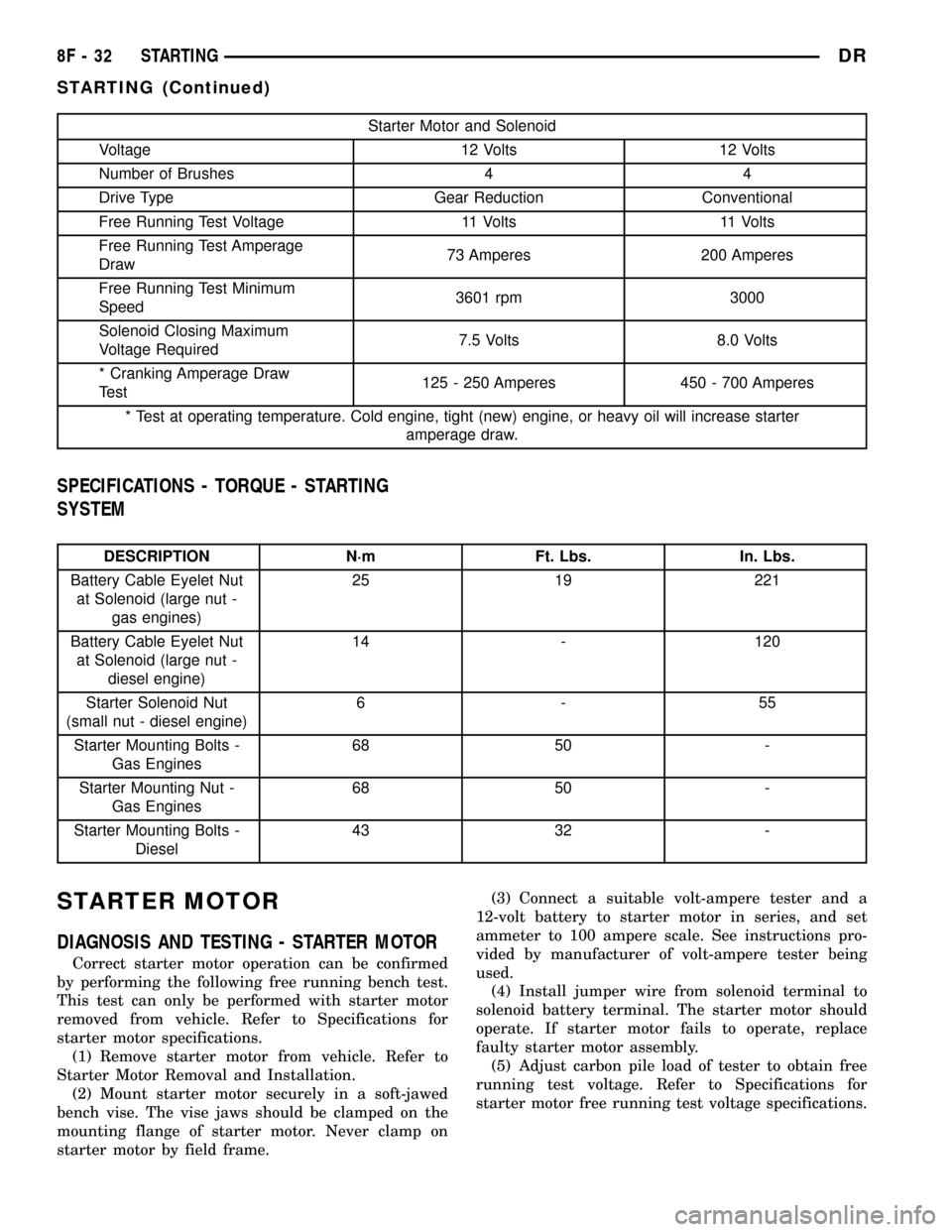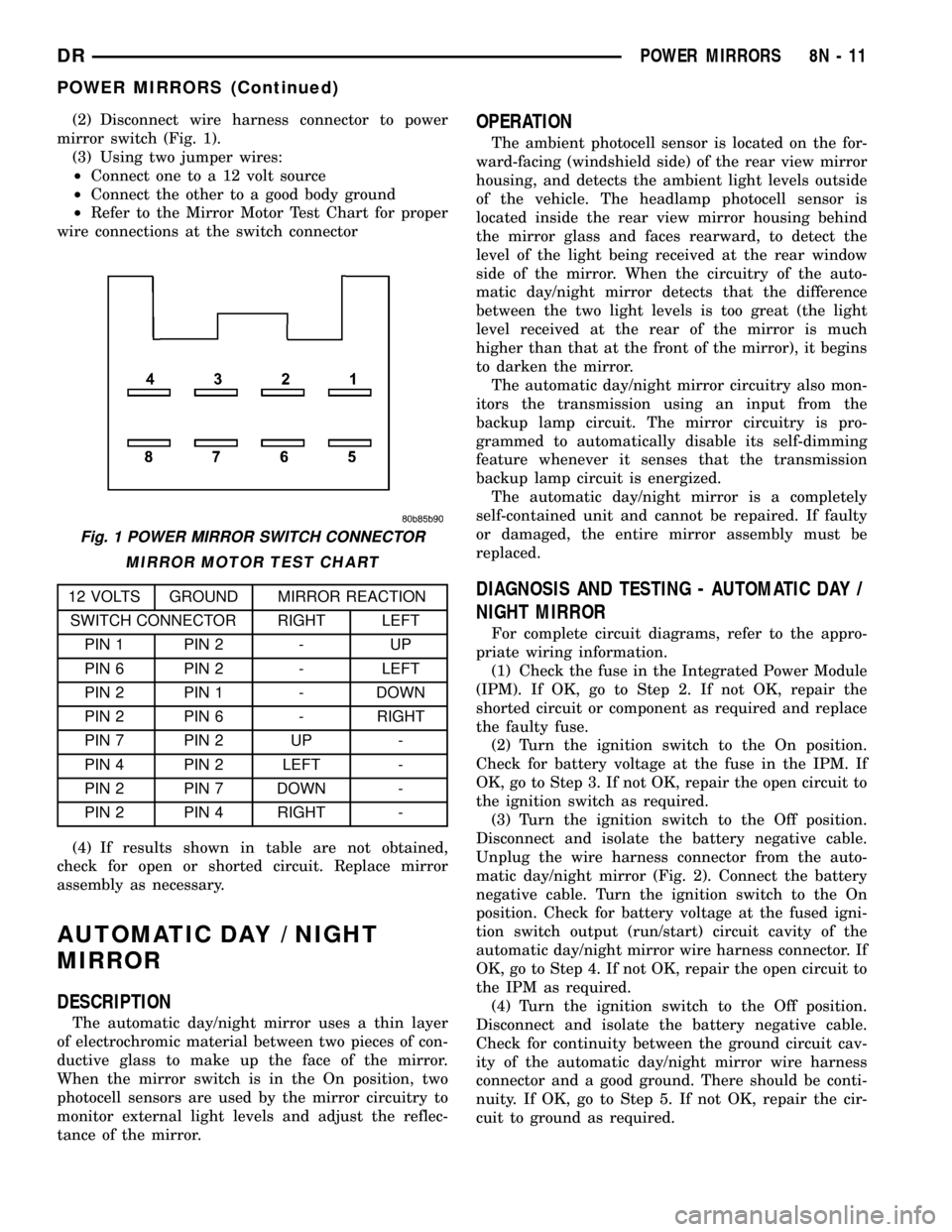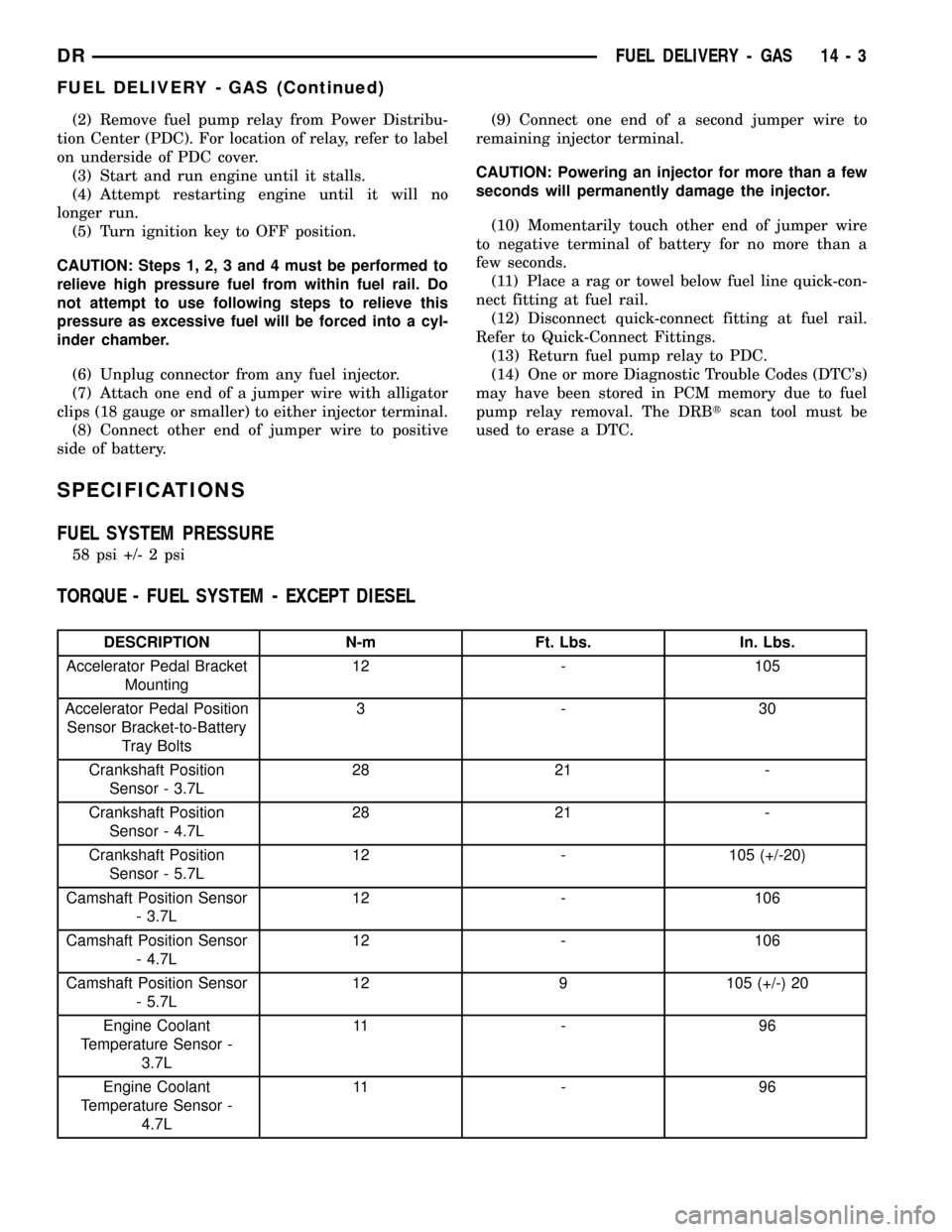jump start DODGE RAM 1500 1998 2.G Workshop Manual
[x] Cancel search | Manufacturer: DODGE, Model Year: 1998, Model line: RAM 1500, Model: DODGE RAM 1500 1998 2.GPages: 2627
Page 14 of 2627

LUBRICATION & MAINTENANCE
TABLE OF CONTENTS
page page
FLUID TYPES
DESCRIPTION
DESCRIPTION - FUEL REQUIREMENTS -
DIESEL ENGINE.......................1
DESCRIPTION - ENGINE OIL AND
LUBRICANTS.........................1
DESCRIPTION - ENGINE OIL - DIESEL
ENGINES............................2
DESCRIPTION - POWER STEERING FLUID . . 3
DESCRIPTION - ENGINE COOLANT........3
DESCRIPTION - TRANSFER CASE.........4
DESCRIPTION - AXLE...................4
DESCRIPTION - MANUAL TRANSMISSION . . . 4
DESCRIPTION - AUTOMATIC
TRANSMISSION FLUID..................4
OPERATION - AUTOMATIC TRANSMISSION
FLUID...............................5FLUID CAPACITIES
SPECIFICATIONS
FLUID CAPACITIES.....................5
MAINTENANCE SCHEDULES
DESCRIPTION
DESCRIPTION........................6
MAINTENANCE SCHEDULES Ð 24±VALVE
CUMMINS TURBO DIESEL..............12
JUMP STARTING
STANDARD PROCEDURE - JUMP STARTING . 19
HOISTING
STANDARD PROCEDURE - HOISTING.......20
TOWING
STANDARD PROCEDURE - TOWING........21
FLUID TYPES
DESCRIPTION
DESCRIPTION - FUEL REQUIREMENTS -
DIESEL ENGINE
DESCRIPTION
WARNING: Do not use alcohol or gasoline as a fuel
blending agent. They can be unstable under certain
conditions and hazardous or explosive when mixed
with diesel fuel.
Use good quality diesel fuel from a reputable sup-
plier in your Dodge truck. For most year-round ser-
vice, number 2 diesel fuel meeting ASTM
specification D-975 will provide good performance. If
the vehicle is exposed to extreme cold (below 0ÉF/-
18ÉC), or is required to operate at colder-than-normal
conditions for prolonged periods, use climatized No. 2
diesel fuel or dilute the No. 2 diesel fuel with 50%
No. 1 diesel fuel. This will provide better protection
from fuel gelling or wax-plugging of the fuel filters.
Diesel fuel is seldom completely free of water. To
prevent fuel system trouble, including fuel line freez-
ing in winter, drain the accumulated water from the
fuel/water separator using the fuel/water separator
drain provided. If you buy good-quality fuel and fol-low the cold-weather advice above, fuel conditioners
should not be required in your vehicle. If available in
your area, a high cetane ªpremiumº diesel fuel may
offer improved cold starting and warm-up perfor-
mance.
DESCRIPTION - ENGINE OIL AND LUBRICANTS
WARNING: NEW OR USED ENGINE OIL CAN BE
IRRITATING TO THE SKIN. AVOID PROLONGED OR
REPEATED SKIN CONTACT WITH ENGINE OIL.
CONTAMINANTS IN USED ENGINE OIL, CAUSED BY
INTERNAL COMBUSTION, CAN BE HAZARDOUS TO
YOUR HEALTH. THOROUGHLY WASH EXPOSED
SKIN WITH SOAP AND WATER. DO NOT WASH
SKIN WITH GASOLINE, DIESEL FUEL, THINNER, OR
SOLVENTS, HEALTH PROBLEMS CAN RESULT. DO
NOT POLLUTE, DISPOSE OF USED ENGINE OIL
PROPERLY. CONTACT YOUR DEALER OR GOVERN-
MENT AGENCY FOR LOCATION OF COLLECTION
CENTER IN YOUR AREA.
When service is required, DaimlerChrysler Corpo-
ration recommends that only Mopartbrand parts,
lubricants and chemicals be used. Mopartprovides
the best engineered products for servicing
DaimlerChrysler Corporation vehicles.
Only lubricants bearing designations defined by
the following organization should be used.
²Society of Automotive Engineers (SAE)
²American Petroleum Institute (API)
DRLUBRICATION & MAINTENANCE 0 - 1
Page 32 of 2627
![DODGE RAM 1500 1998 2.G Workshop Manual Miles 112,500 120,000 127,500 135,000 142,500 150,000
(Kilometers) (181 000) (193 000) (205 000) (217 000) (229 000) (241 000)
[Months] [90] [96] [102] [108] [114] [150]
Inspect front wheel bearings. DODGE RAM 1500 1998 2.G Workshop Manual Miles 112,500 120,000 127,500 135,000 142,500 150,000
(Kilometers) (181 000) (193 000) (205 000) (217 000) (229 000) (241 000)
[Months] [90] [96] [102] [108] [114] [150]
Inspect front wheel bearings.](/img/12/5702/w960_5702-31.png)
Miles 112,500 120,000 127,500 135,000 142,500 150,000
(Kilometers) (181 000) (193 000) (205 000) (217 000) (229 000) (241 000)
[Months] [90] [96] [102] [108] [114] [150]
Inspect front wheel bearings. X X
Inspect brake linings. X X
Inspect and adjust parking
brake if necessary.XX
Adjust valve lash clearance.X
²LTier 1 EPA (250 hp or 305 hp) Engines Only
(see engine data label for your engine type)
²² California LEV (235 hp) Engines Only (see
engine data label for your engine type)
Inspection and service should also be performed
anytime a malfunction is observed or suspected.
WARNING: You can be badly injured working on or
around a motor vehicle. Do only that service work
for which you have the knowledge and the right
equipment. If you have any doubt about your ability
to perform a service job, take your vehicle to a
competent mechanic.
JUMP STARTING
STANDARD PROCEDURE - JUMP STARTING
WARNING: REVIEW ALL SAFETY PRECAUTIONS
AND WARNINGS IN THE BATTERY SYSTEM SEC-
TION OF THE SERVICE MANUAL. (Refer to 8 -
ELECTRICAL/BATTERY SYSTEM/BATTERY - STAN-
DARD PROCEDURE)
²DO NOT JUMP START A FROZEN BATTERY,
PERSONAL INJURY CAN RESULT.
²IF EQUIPPED, DO NOT JUMP START WHEN
MAINTENANCE FREE BATTERY INDICATOR DOT IS
YELLOW OR BRIGHT COLOR.
²DO NOT JUMP START A VEHICLE WHEN THE
BATTERY FLUID IS BELOW THE TOP OF LEAD
PLATES.
²DO NOT ALLOW JUMPER CABLE CLAMPS TO
TOUCH EACH OTHER WHEN CONNECTED TO A
BOOSTER SOURCE.
²DO NOT USE OPEN FLAME NEAR BATTERY.
²REMOVE METALLIC JEWELRY WORN ON
HANDS OR WRISTS TO AVOID INJURY BY ACCI-
DENTAL ARCING OF BATTERY CURRENT.
²WHEN USING A HIGH OUTPUT BOOSTING
DEVICE, DO NOT ALLOW BATTERY VOLTAGE TO
EXCEED 16 VOLTS. REFER TO INSTRUCTIONS
PROVIDED WITH DEVICE BEING USED.FAILURE TO FOLLOW THESE INSTRUCTIONS MAY
RESULT IN PERSONAL INJURY.
CAUTION: When using another vehicle as a
booster, do not allow vehicles to touch. Electrical
systems can be damaged on either vehicle.
TO JUMP START A DISABLED VEHICLE:
(1) Raise hood on disabled vehicle and visually
inspect engine compartment for:
²Battery cable clamp condition, clean if necessary.
²Frozen battery.
²Yellow or bright color test indicator, if equipped.
²Low battery fluid level.
²Generator drive belt condition and tension.
²Fuel fumes or leakage, correct if necessary.
CAUTION: If the cause of starting problem on dis-
abled vehicle is severe, damage to booster vehicle
charging system can result.
(2) When using another vehicle as a booster
source, park the booster vehicle within cable reach.
Turn off all accessories, set the parking brake, place
the automatic transmission in PARK or the manual
transmission in NEUTRAL and turn the ignition
OFF.
(3) On disabled vehicle, place gear selector in park
or neutral and set park brake. Turn off all accesso-
ries.
(4) Connect jumper cables to booster battery. RED
clamp to positive terminal (+). BLACK clamp to neg-
ative terminal (-). DO NOT allow clamps at opposite
end of cables to touch, electrical arc will result.
Review all warnings in this procedure.
(5) On disabled vehicle, connect RED jumper cable
clamp to positive (+) terminal. Connect BLACK
jumper cable clamp to engine ground as close to the
ground cable attaching point as possible.
(6) Start the engine in the vehicle which has the
booster battery, let the engine idle a few minutes,
then start the engine in the vehicle with the dis-
charged battery.
DRLUBRICATION & MAINTENANCE 0 - 19
MAINTENANCE SCHEDULES (Continued)
Page 33 of 2627

CAUTION: Do not crank starter motor on disabled
vehicle for more than 15 seconds, starter will over-
heat and could fail.
(7) Allow battery in disabled vehicle to charge to
at least 12.4 volts (75% charge) before attempting to
start engine. If engine does not start within 15 sec-
onds, stop cranking engine and allow starter to cool
(15 min.), before cranking again.
DISCONNECT CABLE CLAMPS AS FOLLOWS:
²Disconnect BLACK cable clamp from engine
ground on disabled vehicle.
²When using a Booster vehicle, disconnect
BLACK cable clamp from battery negative terminal.
Disconnect RED cable clamp from battery positive
terminal.
²Disconnect RED cable clamp from battery posi-
tive terminal on disabled vehicle.
HOISTING
STANDARD PROCEDURE - HOISTING
Refer to the Owner's Manual for emergency vehicle
lifting procedures.
WARNING: THE HOISTING AND JACK LIFTING
POINTS PROVIDED ARE FOR A COMPLETE VEHI-
CLE. WHEN A CHASSIS OR DRIVETRAIN COMPO-
NENT IS REMOVED FROM A VEHICLE, THE
CENTER OF GRAVITY IS ALTERED MAKING SOME
HOISTING CONDITIONS UNSTABLE. PROPERLY
SUPPORT (Fig. 6) OR SECURE VEHICLE TO HOIST-
ING DEVICE WHEN THESE CONDITIONS EXIST.
FLOOR JACK
When properly positioned, a floor jack can be used
to lift a vehicle (Fig. 7). Support the vehicle in the
raised position with jack stands at the front and rear
ends of the frame rails (Fig. 6).
CAUTION: Do not lift vehicle with a floor jack posi-
tioned under:
²An axle tube.
²A body side sill.
²A steering linkage component.
²A drive shaft.
²The engine or transmission oil pan.
²The fuel tank.
²A front suspension arm.NOTE: Use the correct frame rail lifting locations
only (Fig. 8) and (Fig. 9).
HOIST
A vehicle can be lifted with:
²A single-post, frame-contact hoist.
²A twin-post, chassis hoist.
²A ramp-type, drive-on hoist.
NOTE: When a frame-contact type hoist is used,
verify that the lifting pads are positioned properly
(Fig. 7). The forward lifting pads should be posi-
tioned against the forward flange of the transmis-
sion crossmember brackets at the bottom of the
frame rail (Fig. 8). The real lifting pads should be
wedged between the forward flange of the leaf
spring bracket and the frame rail (Fig. 9). Safety
stands should be placed under the frame rails at
the front and rear ends (Fig. 6).
Fig. 6 Safety Stands
1 - SAFETY STANDS
0 - 20 LUBRICATION & MAINTENANCEDR
JUMP STARTING (Continued)
Page 433 of 2627

For battery system maintenance schedules and
jump starting procedures, see the owner's manual in
the vehicle glove box. Optionally, refer to the Lubri-
cation and Maintenance section of this manual for
the proper battery jump starting procedure. While
battery charging can be considered a maintenance
procedure, the battery charging procedure and
related information are located later in this section of
the service manual. This was done because the bat-
tery must be fully-charged before any battery system
diagnosis or testing procedures can be performed.
OPERATION
The battery system is designed to provide a safe,
efficient, reliable and mobile means of delivering and
storing electrical energy. This electrical energy is
required to operate the engine starting system, as
well as to operate many of the other vehicle acces-
sory systems for limited durations while the engine
and/or the charging system are not operating. The
battery system is also designed to provide a reserve
of electrical energy to supplement the charging sys-
tem for short durations while the engine is running
and the electrical current demands of the vehicle
exceed the output of the charging system. In addition
to delivering, and storing electrical energy for the
vehicle, the battery system serves as a capacitor and
voltage stabilizer for the vehicle electrical system. It
absorbs most abnormal or transient voltages caused
by the switching of any of the electrical components
or circuits in the vehicle.
DIAGNOSIS AND TESTING - BATTERY SYSTEM
The battery, starting, and charging systems in the
vehicle operate with one another and must be tested
as a complete system. In order for the engine to start
and the battery to maintain its charge properly, all of
the components that are used in these systems must
perform within specifications. It is important thatthe battery, starting, and charging systems be thor-
oughly tested and inspected any time a battery needs
to be charged or replaced. The cause of abnormal bat-
tery discharge, overcharging or early battery failure
must be diagnosed and corrected before a battery is
replaced and before a vehicle is returned to service.
The service information for these systems has been
separated within this service manual to make it eas-
ier to locate the specific information you are seeking.
However, when attempting to diagnose any of these
systems, it is important that you keep their interde-
pendency in mind.
The diagnostic procedures used for the battery,
starting, and charging systems include the most
basic conventional diagnostic methods, to the more
sophisticated On-Board Diagnostics (OBD) built into
the Powertrain Control Module (PCM). Use of an
induction-type milliampere ammeter, a volt/ohmme-
ter, a battery charger, a carbon pile rheostat (load
tester), a 12-volt test lamp and/or special service
tools may be required. All OBD-sensed systems are
monitored by the PCM. Each monitored circuit is
assigned a Diagnostic Trouble Code (DTC). The PCM
will store a DTC in electronic memory for any failure
it detects. Always check the PCM for stored trouble
codes before returning the vehicle to service. Refer to
Charging System for the proper charging system test
procedures. Refer to Starting System for the proper
starting system test procedures.
MICRO 420 BATTERY TESTER
The Micro 420 automotive battery tester is
designed to help the dealership technician diagnose a
defective battery. Follow the instruction manual sup-
plied with the tester to properly diagnose a battery.
If the instruction manual is not available, refer to
the standard procedure in this section, which
includes the directions for using the Micro 420 bat-
tery tester.
8F - 2 BATTERY SYSTEMDR
BATTERY SYSTEM (Continued)
Page 463 of 2627

Starter Motor and Solenoid
Voltage 12 Volts 12 Volts
Number of Brushes 4 4
Drive Type Gear Reduction Conventional
Free Running Test Voltage 11 Volts 11 Volts
Free Running Test Amperage
Draw73 Amperes 200 Amperes
Free Running Test Minimum
Speed3601 rpm 3000
Solenoid Closing Maximum
Voltage Required7.5 Volts 8.0 Volts
* Cranking Amperage Draw
Test125 - 250 Amperes 450 - 700 Amperes
* Test at operating temperature. Cold engine, tight (new) engine, or heavy oil will increase starter
amperage draw.
SPECIFICATIONS - TORQUE - STARTING
SYSTEM
DESCRIPTION N´m Ft. Lbs. In. Lbs.
Battery Cable Eyelet Nut
at Solenoid (large nut -
gas engines)25 19 221
Battery Cable Eyelet Nut
at Solenoid (large nut -
diesel engine)14 - 120
Starter Solenoid Nut
(small nut - diesel engine)6-55
Starter Mounting Bolts -
Gas Engines68 50 -
Starter Mounting Nut -
Gas Engines68 50 -
Starter Mounting Bolts -
Diesel43 32 -
STARTER MOTOR
DIAGNOSIS AND TESTING - STARTER MOTOR
Correct starter motor operation can be confirmed
by performing the following free running bench test.
This test can only be performed with starter motor
removed from vehicle. Refer to Specifications for
starter motor specifications.
(1) Remove starter motor from vehicle. Refer to
Starter Motor Removal and Installation.
(2) Mount starter motor securely in a soft-jawed
bench vise. The vise jaws should be clamped on the
mounting flange of starter motor. Never clamp on
starter motor by field frame.(3) Connect a suitable volt-ampere tester and a
12-volt battery to starter motor in series, and set
ammeter to 100 ampere scale. See instructions pro-
vided by manufacturer of volt-ampere tester being
used.
(4) Install jumper wire from solenoid terminal to
solenoid battery terminal. The starter motor should
operate. If starter motor fails to operate, replace
faulty starter motor assembly.
(5) Adjust carbon pile load of tester to obtain free
running test voltage. Refer to Specifications for
starter motor free running test voltage specifications.
8F - 32 STARTINGDR
STARTING (Continued)
Page 608 of 2627

(2) Disconnect wire harness connector to power
mirror switch (Fig. 1).
(3) Using two jumper wires:
²Connect one to a 12 volt source
²Connect the other to a good body ground
²Refer to the Mirror Motor Test Chart for proper
wire connections at the switch connector
MIRROR MOTOR TEST CHART
12 VOLTS GROUND MIRROR REACTION
SWITCH CONNECTOR RIGHT LEFT
PIN 1 PIN 2 - UP
PIN 6 PIN 2 - LEFT
PIN 2 PIN 1 - DOWN
PIN 2 PIN 6 - RIGHT
PIN 7 PIN 2 UP -
PIN 4 PIN 2 LEFT -
PIN 2 PIN 7 DOWN -
PIN 2 PIN 4 RIGHT -
(4) If results shown in table are not obtained,
check for open or shorted circuit. Replace mirror
assembly as necessary.
AUTOMATIC DAY / NIGHT
MIRROR
DESCRIPTION
The automatic day/night mirror uses a thin layer
of electrochromic material between two pieces of con-
ductive glass to make up the face of the mirror.
When the mirror switch is in the On position, two
photocell sensors are used by the mirror circuitry to
monitor external light levels and adjust the reflec-
tance of the mirror.
OPERATION
The ambient photocell sensor is located on the for-
ward-facing (windshield side) of the rear view mirror
housing, and detects the ambient light levels outside
of the vehicle. The headlamp photocell sensor is
located inside the rear view mirror housing behind
the mirror glass and faces rearward, to detect the
level of the light being received at the rear window
side of the mirror. When the circuitry of the auto-
matic day/night mirror detects that the difference
between the two light levels is too great (the light
level received at the rear of the mirror is much
higher than that at the front of the mirror), it begins
to darken the mirror.
The automatic day/night mirror circuitry also mon-
itors the transmission using an input from the
backup lamp circuit. The mirror circuitry is pro-
grammed to automatically disable its self-dimming
feature whenever it senses that the transmission
backup lamp circuit is energized.
The automatic day/night mirror is a completely
self-contained unit and cannot be repaired. If faulty
or damaged, the entire mirror assembly must be
replaced.
DIAGNOSIS AND TESTING - AUTOMATIC DAY /
NIGHT MIRROR
For complete circuit diagrams, refer to the appro-
priate wiring information.
(1) Check the fuse in the Integrated Power Module
(IPM). If OK, go to Step 2. If not OK, repair the
shorted circuit or component as required and replace
the faulty fuse.
(2) Turn the ignition switch to the On position.
Check for battery voltage at the fuse in the IPM. If
OK, go to Step 3. If not OK, repair the open circuit to
the ignition switch as required.
(3) Turn the ignition switch to the Off position.
Disconnect and isolate the battery negative cable.
Unplug the wire harness connector from the auto-
matic day/night mirror (Fig. 2). Connect the battery
negative cable. Turn the ignition switch to the On
position. Check for battery voltage at the fused igni-
tion switch output (run/start) circuit cavity of the
automatic day/night mirror wire harness connector. If
OK, go to Step 4. If not OK, repair the open circuit to
the IPM as required.
(4) Turn the ignition switch to the Off position.
Disconnect and isolate the battery negative cable.
Check for continuity between the ground circuit cav-
ity of the automatic day/night mirror wire harness
connector and a good ground. There should be conti-
nuity. If OK, go to Step 5. If not OK, repair the cir-
cuit to ground as required.
Fig. 1 POWER MIRROR SWITCH CONNECTOR
DRPOWER MIRRORS 8N - 11
POWER MIRRORS (Continued)
Page 1572 of 2627

(2) Remove fuel pump relay from Power Distribu-
tion Center (PDC). For location of relay, refer to label
on underside of PDC cover.
(3) Start and run engine until it stalls.
(4) Attempt restarting engine until it will no
longer run.
(5) Turn ignition key to OFF position.
CAUTION: Steps 1, 2, 3 and 4 must be performed to
relieve high pressure fuel from within fuel rail. Do
not attempt to use following steps to relieve this
pressure as excessive fuel will be forced into a cyl-
inder chamber.
(6) Unplug connector from any fuel injector.
(7) Attach one end of a jumper wire with alligator
clips (18 gauge or smaller) to either injector terminal.
(8) Connect other end of jumper wire to positive
side of battery.(9) Connect one end of a second jumper wire to
remaining injector terminal.
CAUTION: Powering an injector for more than a few
seconds will permanently damage the injector.
(10) Momentarily touch other end of jumper wire
to negative terminal of battery for no more than a
few seconds.
(11) Place a rag or towel below fuel line quick-con-
nect fitting at fuel rail.
(12) Disconnect quick-connect fitting at fuel rail.
Refer to Quick-Connect Fittings.
(13) Return fuel pump relay to PDC.
(14) One or more Diagnostic Trouble Codes (DTC's)
may have been stored in PCM memory due to fuel
pump relay removal. The DRBtscan tool must be
used to erase a DTC.
SPECIFICATIONS
FUEL SYSTEM PRESSURE
58 psi +/- 2 psi
TORQUE - FUEL SYSTEM - EXCEPT DIESEL
DESCRIPTION N-m Ft. Lbs. In. Lbs.
Accelerator Pedal Bracket
Mounting12 - 105
Accelerator Pedal Position
Sensor Bracket-to-Battery
Tray Bolts3-30
Crankshaft Position
Sensor - 3.7L28 21 -
Crankshaft Position
Sensor - 4.7L28 21 -
Crankshaft Position
Sensor - 5.7L12 - 105 (+/-20)
Camshaft Position Sensor
- 3.7L12 - 106
Camshaft Position Sensor
- 4.7L12 - 106
Camshaft Position Sensor
- 5.7L12 9 105 (+/-) 20
Engine Coolant
Temperature Sensor -
3.7L11 - 9 6
Engine Coolant
Temperature Sensor -
4.7L11 - 9 6
DRFUEL DELIVERY - GAS 14 - 3
FUEL DELIVERY - GAS (Continued)
Page 2605 of 2627

INTAKE AIR HEATER - OPERATION.......14-80
INTAKE AIR HEATER - REMOVAL........14-80
INTAKE AIR HEATER RELAY -
DESCRIPTION.......................14-82
INTAKE AIR HEATER RELAY -
INSTALLATION.......................14-82
INTAKE AIR HEATER RELAY -
OPERATION.........................14-82
INTAKE AIR HEATER RELAY - REMOVAL . . 14-82
INTAKE AIR TEMPERATURE SENSOR -
DESCRIPTION.......................14-30
INTAKE AIR TEMPERATURE SENSOR -
INSTALLATION.......................14-31
INTAKE AIR TEMPERATURE SENSOR -
OPERATION.........................14-30
INTAKE AIR TEMPERATURE SENSOR -
REMOVAL..........................14-30
INTAKE AIR TEMPERATURE SENSOR/
MAP SENSOR - DESCRIPTION..........14-82
INTAKE AIR TEMPERATURE SENSOR/
MAP SENSOR - INSTALLATION..........14-82
INTAKE AIR TEMPERATURE SENSOR/
MAP SENSOR - OPERATION............14-82
INTAKE AIR TEMPERATURE SENSOR/
MAP SENSOR - REMOVAL.............14-82
INTAKE MANIFOLD - CLEANING....9-160,9-226,
9-297
INTAKE MANIFOLD - DESCRIPTION . 9-159,9-225,
9-72
INTAKE MANIFOLD - INSPECTION . . 9-160,9-226,
9-297
INTAKE MANIFOLD - INSTALLATION.....9-160,
9-226,9-298,9-73
INTAKE MANIFOLD - REMOVAL....9-159,9-226,
9-297,9-73
INTAKE MANIFOLD LEAKAGE -
DIAGNOSIS AND TESTING........9-159,9-225
INTAKE MANIFOLD LEAKS - DIAGNOSIS
AND TESTING........................9-72
INTAKE SYSTEM - INSTALLATION, AIR....9-199
INTAKE SYSTEM - REMOVAL, AIR.......9-199
INTAKE/EXHAUST VALVES & SEATS -
DESCRIPTION..............9-123,9-256,9-28
INTAKE/EXHAUST VALVES & SEATS -
INSTALLATION...................9-124,9-30
INTAKE/EXHAUST VALVES & SEATS -
REMOVAL......................9-124,9-29
INTEGRATED POWER MODULE -
DESCRIPTION.....................8W-97-3
INTEGRATED POWER MODULE -
INSTALLATION....................8W-97-4
INTEGRATED POWER MODULE -
OPERATION.......................8W-97-3
INTEGRATED POWER MODULE -
REMOVAL........................8W-97-3
INTERIOR - CAUTION.................23-62
INTERLOCK - ADJUSTMENTS, BRAKE
TRANSMISSION SHIFT.........21-196,21-365
INTERLOCK - DIAGNOSIS AND TESTING,
BRAKE TRANSMISSION SHIFT . . . 21-196,21-364
INTERLOCK SYSTEM - DESCRIPTION,
BRAKE TRANSMISSION SHIFT . . . 21-196,21-364
INTERLOCK SYSTEM - OPERATION,
BRAKE TRANSMISSION SHIFT . . . 21-196,21-364
INTERNATIONAL SYMBOLS -
DESCRIPTION......................Intro.-5
INVERTED FLARING - STANDARD
PROCEDURE, DOUBLE.................5-10
IOD FUSE - DESCRIPTION...........8W-97-6
IOD FUSE - INSTALLATION...........8W-97-7
IOD FUSE - OPERATION.............8W-97-6
IOD FUSE - REMOVAL..............8W-97-7
ISO FLARING - STANDARD PROCEDURE
. . . 5-11
ISOLATORS - INSTALLATION, BODY
......23-37
ISOLATORS - REMOVAL, BODY
.........23-36
JOINT - DIAGNOSIS AND TESTING,
LOWER BALL
....................2-19,2-34
JOINT - DIAGNOSIS AND TESTING,
UPPER BALL
.....................2-27,2-36
JOINT - INSTALLATION, LOWER BALL
. 2-20,2-35
JOINT - INSTALLATION, UPPER BALL
.....2-36
JOINT - REMOVAL, LOWER BALL
.....2-19,2-35
JOINT - REMOVAL, UPPER BALL
.........2-36
JOINT-INNER - INSTALLATION, CV
........3-25
JOINT-INNER - REMOVAL, CV
............3-25
JOINT-OUTER - INSTALLATION, CV
........3-23
JOINT-OUTER - REMOVAL, CV
...........3-22JOINTS - ASSEMBLY, DOUBLE CARDAN
UNIVERSAL..........................3-17
JOINTS - DISASSEMBLY, DOUBLE
CARDAN UNIVERSAL..................3-16
JOUNCE BUMPER - INSTALLATION.......2-43
JOUNCE BUMPER - REMOVAL...........2-43
JOURNAL CLEARANCE - STANDARD
PROCEDURE, CONNECTING ROD
BEARING AND CRANKSHAFT...........9-272
JUMP STARTING - STANDARD
PROCEDURE.........................0-19
JUNCTION BLOCK - INSTALLATION,
BRAKE..............................5-24
JUNCTION BLOCK - REMOVAL, BRAKE....5-24
KEY CYLINDER - INSTALLATION.........19-12
KEY CYLINDER - REMOVAL............19-12
KEY IMMOBILIZER MODULE -
DESCRIPTION, SENTRY................8E-13
KEY IMMOBILIZER MODULE -
INSTALLATION, SENTRY...............8E-15
KEY IMMOBILIZER MODULE -
OPERATION, SENTRY.................8E-13
KEY IMMOBILIZER MODULE - REMOVAL,
SENTRY............................8E-15
KEY IMMOBILIZER MODULE (SKIM) -
DESCRIPTION, SENTRY................8Q-1
KEY IMMOBILIZER MODULE (SKIM) -
OPERATION, SENTRY..................8Q-2
KEY IMMOBILIZER SYSTEM INDICATOR
LAMP - DESCRIPTION, SENTRY..........8Q-5
KEY IMMOBILIZER SYSTEM INDICATOR
LAMP - OPERATION, SENTRY...........8Q-5
KEY IMMOBILIZER SYSTEM
INITIALIZATION, STANDARD
PROCEDURE - SENTRY................8Q-3
KEY IMMOBILIZER SYSTEM (SKIS) -
DESCRIPTION, SENTRY................8Q-1
KEY IMMOBILIZER SYSTEM (SKIS) -
OPERATION, SENTRY..................8Q-2
KEY IMMOBILIZER SYSTEM
TRANSPONDER PROGRAMMING,
STANDARD PROCEDURE - SENTRY.......8Q-4
KEY LOCK CYLINDER - DIAGNOSIS AND
TESTING, IGNITION SWITCH............19-11
KEY-IN IGNITION SWITCH -
DESCRIPTION.......................19-11
KEYLESS ENTRY MODULE -
DESCRIPTION, REMOTE................8N-7
KEYLESS ENTRY MODULE - DIAGNOSIS
AND TESTING, REMOTE................8N-7
KEYLESS ENTRY MODULE -
INSTALLATION, REMOTE...............8N-8
KEYLESS ENTRY MODULE - OPERATION,
REMOTE............................8N-7
KEYLESS ENTRY MODULE - REMOVAL,
REMOTE............................8N-7
KEYLESS ENTRY TRANSMITTER -
DIAGNOSIS AND TESTING, REMOTE......8N-8
KEYLESS ENTRY TRANSMITTER -
SPECIFICATIONS, REMOTE..............8N-9
KNOB RELEASE - INSTALLATION, TILT
LEVER.............................19-16
KNOB RELEASE - REMOVAL, TILT LEVER . . 19-16
KNOCK SENSOR - DESCRIPTION.........8I-14
KNOCK SENSOR - INSTALLATION........8I-15
KNOCK SENSOR - OPERATION..........8I-14
KNOCK SENSOR - REMOVAL............8I-15
KNUCKLE - DESCRIPTION...............2-18
KNUCKLE - INSTALLATION..........2-19,2-37
KNUCKLE - OPERATION................2-18
KNUCKLE - REMOVAL..............2-18,2-37
LABEL - DESCRIPTION, VEHICLE
CERTIFICATION....................Intro.-11
LAMP - DESCRIPTION, DOME...........8L-26
LAMP - DESCRIPTION, READING........8L-28
LAMP - DESCRIPTION, SENTRY KEY
IMMOBILIZER SYSTEM INDICATOR.......8Q-5
LAMP - INSTALLATION, CAB CLEARANCE . 8L-12
LAMP - INSTALLATION, CENTER HIGH
MOUNTED STOP.....................8L-11
LAMP - INSTALLATION, DOME..........8L-26
LAMP - INSTALLATION, FENDER
MARKER
...........................8L-18
LAMP - INSTALLATION, FOG
............8L-12
LAMP - INSTALLATION, LICENSE PLATE
. . 8L-17
LAMP - INSTALLATION, PARK/TURN
SIGNAL
............................8L-21
LAMP - INSTALLATION, READING
........8L-29LAMP - INSTALLATION, TAILGATE
MARKER...........................8L-18
LAMP - INSTALLATION, UNDERHOOD....8L-25
LAMP - OPERATION, DOME............8L-26
LAMP - OPERATION, READING..........8L-28
LAMP - OPERATION, SENTRY KEY
IMMOBILIZER SYSTEM INDICATOR.......8Q-5
LAMP - REMOVAL, CAB CLEARANCE.....8L-11
LAMP - REMOVAL, CENTER HIGH
MOUNTED STOP.....................8L-11
LAMP - REMOVAL, DOME..............8L-26
LAMP - REMOVAL, FENDER MARKER....8L-17
LAMP - REMOVAL, FOG...............8L-12
LAMP - REMOVAL, LICENSE PLATE......8L-17
LAMP - REMOVAL, PARK/TURN SIGNAL . . 8L-21
LAMP - REMOVAL, READING...........8L-28
LAMP - REMOVAL, TAILGATE MARKER . . . 8L-18
LAMP - REMOVAL, UNDERHOOD........8L-25
LAMP INDICATOR - DESCRIPTION,
CARGO.............................8J-20
LAMP INDICATOR - OPERATION, CARGO . . 8J-20
LAMP (MIL) - DESCRIPTION,
MALFUNCTION INDICATOR.............8J-31
LAMP (MIL) - OPERATION,
MALFUNCTION INDICATOR.............8J-31
LAMP OUT INDICATOR - DESCRIPTION . . . 8J-29
LAMP OUT INDICATOR - OPERATION.....8J-29
LAMP RELAY - DESCRIPTION, FOG......8L-12
LAMP RELAY - DESCRIPTION, PARK.....8L-20
LAMP RELAY - DIAGNOSIS AND
TESTING, PARK......................8L-20
LAMP RELAY - INSTALLATION, FOG......8L-13
LAMP RELAY - INSTALLATION, PARK.....8L-21
LAMP RELAY - OPERATION, FOG........8L-13
LAMP RELAY - OPERATION, PARK.......8L-20
LAMP RELAY - REMOVAL, FOG.........8L-13
LAMP RELAY - REMOVAL, PARK........8L-21
LAMP REPLACEMENT - STANDARD
PROCEDURE, MODULE................8M-3
LAMP REPLACEMENT - STANDARD
PROCEDURE, READING/COURTESY.......8M-3
LAMP SWITCH - DESCRIPTION, BACKUP . . . 8L-8
LAMP SWITCH - DESCRIPTION, BRAKE....8L-9
LAMP SWITCH - DIAGNOSIS AND
TESTING, BACKUP.....................8L-8
LAMP SWITCH - DIAGNOSIS AND
TESTING, BRAKE.....................8L-10
LAMP SWITCH - INSTALLATION, BRAKE . . 8L-11
LAMP SWITCH - OPERATION, BACKUP....8L-8
LAMP SWITCH - OPERATION, BRAKE......8L-9
LAMP SWITCH - REMOVAL, BRAKE......8L-10
LAMP UNIT - INSTALLATION, CENTER
HIGH MOUNTED STOP................8L-11
LAMP UNIT - INSTALLATION, LICENSE
PLATE .............................8L-17
LAMP UNIT - INSTALLATION,
UNDERHOOD........................8L-25
LAMP UNIT - REMOVAL, CENTER HIGH
MOUNTED STOP.....................8L-11
LAMP UNIT - REMOVAL, LICENSE PLATE . . 8L-17
LAMP UNIT - REMOVAL, UNDERHOOD . . . 8L-25
LAMPS, SPECIFICATIONS - EXTERIOR.....8L-7
LAMPS/LIGHTING - EXTERIOR -
DESCRIPTION........................8L-2
LAMPS/LIGHTING - EXTERIOR -
DIAGNOSIS AND TESTING..............8L-3
LAMPS/LIGHTING - EXTERIOR -
OPERATION..........................8L-2
LAMP/SWITCH - INSTALLATION, GLOVE
BOX ...............................8L-28
LAMP/SWITCH - REMOVAL, GLOVE BOX . . 8L-27
LASH ADJUSTER - DIAGNOSIS AND
TESTING, HYDRAULIC.............9-125,9-32
LASH ADJUSTMENT AND VERIFICATION
- STANDARD PROCEDURE, VALVE.......9-259
LATCH - INSTALLATION.....23-16,23-23,23-32,
23-47
LATCH - INSTALLATION, GLOVE BOX.....23-52
LATCH - INSTALLATION, UNDER SEAT
STORAGE BIN.......................23-80
LATCH - REMOVAL
....23-16,23-23,23-32,23-47
LATCH - REMOVAL, GLOVE BOX
.........23-52
LATCH - REMOVAL, UNDER SEAT
STORAGE BIN
.......................23-80
LATCH RELEASE CABLE/HANDLE
ASSEMBLY - INSTALLATION
............23-47
LATCH RELEASE CABLE/HANDLE
ASSEMBLY - REMOVAL
................23-47
18 INDEXDR
Description Group-Page Description Group-Page Description Group-Page
Page 2618 of 2627

SOLENOID - DESCRIPTION, EVAP/PURGE . 25-12
SOLENOID - INSTALLATION, EVAP/
PURGE.............................25-12
SOLENOID - OPERATION..............21-252
SOLENOID - OPERATION, EVAP/PURGE . . . 25-12
SOLENOID - REMOVAL, EVAP/PURGE.....25-12
SOLENOID SWITCH VALVE -
DESCRIPTION......................21-398
SOLENOID SWITCH VALVE - OPERATION . 21-398
SOLENOIDS - DESCRIPTION...........21-398
SOLENOIDS - OPERATION.............21-399
SOLENOID/TRS ASSEMBLY -
DESCRIPTION, TRANSMISSION........21-406
SOLENOID/TRS ASSEMBLY -
INSTALLATION, TRANSMISSION........21-408
SOLENOID/TRS ASSEMBLY -
OPERATION, TRANSMISSION..........21-406
SOLENOID/TRS ASSEMBLY - REMOVAL,
TRANSMISSION.....................21-407
SOLID LIFTERS/TAPPETS - CLEANING....9-279
SOLID LIFTERS/TAPPETS - INSPECTION . . 9-279
SOLID LIFTERS/TAPPETS -
INSTALLATION.......................9-280
SOLID LIFTERS/TAPPETS - REMOVAL....9-279
SPARE / TEMPORARY TIRE -
DESCRIPTION.......................22-15
SPARE TIRE / TEMPORARY -
DESCRIPTION........................22-6
SPARE WHEEL WITH MATCHING TIRE -
DESCRIPTION, FULL SIZE..............22-15
SPARK PLUG - DESCRIPTION...........8I-17
SPARK PLUG - REMOVAL..............8I-19
SPARK PLUG CABLE - DESCRIPTION.....8I-21
SPARK PLUG CABLE - INSTALLATION.....8I-22
SPARK PLUG CABLE - OPERATION.......8I-21
SPARK PLUG CABLE - REMOVAL........8I-22
SPARK PLUG CABLE RESISTANCE,
SPECIFICATIONS......................8I-4
SPARK PLUG CONDITIONS - DIAGNOSIS
AND TESTING........................8I-17
SPARK PLUGS, SPECIFICATIONS..........8I-4
SPEAKER - DESCRIPTION..............8A-13
SPEAKER - DIAGNOSIS AND TESTING....8A-13
SPEAKER - INSTALLATION.............8A-15
SPEAKER - OPERATION...............8A-13
SPEAKER - REMOVAL.................8A-14
SPECIFICATIONS......................7-20
SPEED CONTROL - DESCRIPTION........8P-1
SPEED CONTROL - OPERATION..........8P-2
SPEED CONTROL - TORQUE.............8P-3
SPEED SENSOR - DESCRIPTION........21-253
SPEED SENSOR - DESCRIPTION, FRONT
WHEEL.............................5-47
SPEED SENSOR - DESCRIPTION, INPUT . 21-382
SPEED SENSOR - DESCRIPTION,
OUTPUT...........................21-391
SPEED SENSOR - DIAGNOSIS AND
TESTING, REAR WHEEL................5-49
SPEED SENSOR - INSTALLATION, FRONT
WHEEL.............................5-48
SPEED SENSOR - INSTALLATION, INPUT . 21-382
SPEED SENSOR - INSTALLATION,
OUTPUT...........................21-392
SPEED SENSOR - INSTALLATION, REAR
WHEEL.............................5-48
SPEED SENSOR - OPERATION.........21-253
SPEED SENSOR - OPERATION, FRONT
WHEEL.............................5-47
SPEED SENSOR - OPERATION, INPUT . . . 21-382
SPEED SENSOR - OPERATION, OUTPUT . . 21-391
SPEED SENSOR - REMOVAL, FRONT
WHEEL.............................5-48
SPEED SENSOR - REMOVAL, INPUT.....21-382
SPEED SENSOR - REMOVAL, OUTPUT . . . 21-391
SPEED SENSOR - REMOVAL, REAR
WHEEL.............................5-48
SPEEDOMETER - DESCRIPTION.........8J-37
SPEEDOMETER - OPERATION...........8J-37
SPEEDS - DESCRIPTION, TIRE
PRESSURE FOR HIGH
..................22-7
SPLASH SHIELD - INSTALLATION,
FRONT WHEELHOUSE
.................23-41
SPLASH SHIELD - INSTALLATION, REAR
WHEELHOUSE
.......................23-41
SPLASH SHIELD - REMOVAL, FRONT
WHEELHOUSE
.......................23-41
SPLASH SHIELD - REMOVAL, REAR
WHEELHOUSE
.......................23-41SPLICE INFORMATION - DESCRIPTION,
CONNECTOR, GROUND..............8W-01-7
SPLICING - STANDARD PROCEDURE,
WIRE...........................8W-01-15
SPRING - DESCRIPTION................2-44
SPRING - INSTALLATION.......2-23,2-39,2-44
SPRING - OPERATION..................2-44
SPRING - REMOVAL...........2-22,2-39,2-44
SPRING AND SHOCK - DIAGNOSIS AND
TESTING............................2-41
SPRING BUMPERS (3500) -
INSTALLATION, AUXILIARY..............2-43
SPRING BUMPERS (3500) - REMOVAL,
AUXILIARY..........................2-43
SPRING TIP INSERTS - INSTALLATION....2-45
SPRING TIP INSERTS - REMOVAL........2-44
SPRINGS - DESCRIPTION, VALVE . . . 9-126,9-32,
9-38
SPRINGS - INSTALLATION, VALVE . . 9-127,9-204,
9-32,9-38
SPRINGS - REMOVAL, VALVE . 9-126,9-204,9-32,
9-38
SPRINGS - STANDARD PROCEDURE,
VALVES, GUIDES.....................9-256
SPRINGS AND SEALS - REMOVAL,
VALVE .............................9-260
SPROCKETS - INSPECTION, TIMING
BELT/CHAIN.....................9-174,9-84
SPROCKETS - INSTALLATION, TIMING
BELT/CHAIN.....................9-176,9-85
SPROCKETS - INSTALLATION,
TIMING/CHAIN........................9-228
SPROCKETS - REMOVAL, TIMING
BELT/CHAIN.....................9-172,9-83
SPROCKETS - REMOVAL, TIMING/CHAIN . . 9-228
SQUEAK & RATTLE - STANDARD
PROCEDURE, BUZZ...................23-11
STABILIZER BAR - DESCRIPTION.........2-24
STABILIZER BAR - INSTALLATION....2-25,2-40
STABILIZER BAR - OPERATION...........2-25
STABILIZER BAR - REMOVAL........2-25,2-39
STAKING - STANDARD PROCEDURE,
HEAT ...............................23-3
STANDARD CAB - INSTALLATION . . 8O-35,8O-61
STANDARD CAB - REMOVAL......8O-32,8O-59
STARTER MOTOR - DIAGNOSIS AND
TESTING...........................8F-32
STARTER MOTOR - INSTALLATION.......8F-34
STARTER MOTOR - REMOVAL..........8F-33
STARTER MOTOR RELAY - DESCRIPTION . 8F-35
STARTER MOTOR RELAY -
INSTALLATION.......................8F-37
STARTER MOTOR RELAY - OPERATION . . . 8F-36
STARTER MOTOR RELAY - REMOVAL.....8F-37
STARTER RELAY - DIAGNOSIS AND
TESTING...........................8F-36
STARTING - DESCRIPTION.............8F-26
STARTING - OPERATION...............8F-26
STARTING - STANDARD PROCEDURE,
JUMP...............................0-19
STARTING SYSTEM - DIAGNOSIS AND
TESTING...........................8F-27
STARTING SYSTEM - SPECIFICATIONS,
TORQUE............................8F-32
STARTING SYSTEM, SPECIFICATIONS
.....8F-31
STATE DISPLAY TEST MODE -
DESCRIPTION
........................25-1
STEERING - DESCRIPTION
..............19-1
STEERING - OPERATION
................19-1
STEERING COLUMN - DIAGNOSIS AND
TESTING
............................19-7
STEERING COLUMN OPENING COVER -
INSTALLATION
.......................23-60
STEERING COLUMN OPENING COVER -
REMOVAL
..........................23-60
STEERING COLUMN OPENING SUPPORT
BRACKET - INSTALLATION
.............23-60
STEERING COLUMN OPENING SUPPORT
BRACKET - REMOVAL
.................23-60
STEERING COUPLING - INSTALLATION,
UPPER
.............................19-13
STEERING COUPLING - REMOVAL,
UPPER
.............................19-13
STEERING FLOW AND PRESSURE -
DIAGNOSIS AND TESTING, POWER
.......19-4
STEERING FLUID - DESCRIPTION,
POWER
..............................0-3STEERING FLUID LEVEL CHECKING -
STANDARD PROCEDURE, POWER.......19-43
STEERING GEAR INPUT SHAFT SEAL -
INSTALLATION.......................19-29
STEERING GEAR INPUT SHAFT SEAL -
REMOVAL..........................19-27
STEERING GEAR, SPECIAL TOOLS -
POWER............................19-23
STEERING GEAR, SPECIFICATIONS -
POWER............................19-22
STEERING LINKAGE, SPECIAL TOOLS....19-35
STEERING PRESSURE SWITCH -
DESCRIPTION, POWER................19-46
STEERING PRESSURE SWITCH -
OPERATION, POWER..................19-46
STEERING PUMP - INITIAL OPERATION -
STANDARD PROCEDURE, POWER.......19-40
STEERING, SPECIAL TOOLS.............19-5
STEERING SYSTEM - DIAGNOSIS AND
TESTING, POWER.....................19-2
STEERING SYSTEM - STANDARD
PROCEDURE, FLUSHING POWER........19-40
STEERING WHEEL - INSTALLATION......19-15
STEERING WHEEL - REMOVAL..........19-15
STEM SEALS - DESCRIPTION, VALVE....9-127,
9-203
STOP LAMP - INSTALLATION, CENTER
HIGH MOUNTED.....................8L-11
STOP LAMP - REMOVAL, CENTER HIGH
MOUNTED..........................8L-11
STOP LAMP UNIT - INSTALLATION,
CENTER HIGH MOUNTED..............8L-11
STOP LAMP UNIT - REMOVAL, CENTER
HIGH MOUNTED.....................8L-11
STORAGE BIN - INSTALLATION..........23-61
STORAGE BIN - INSTALLATION, UNDER
SEAT ..............................23-80
STORAGE BIN - REMOVAL.............23-61
STORAGE BIN - REMOVAL, UNDER SEAT . . 23-80
STORAGE BIN COVERING -
INSTALLATION, UNDER SEAT...........23-80
STORAGE BIN COVERING - REMOVAL,
UNDER SEAT........................23-80
STORAGE BIN LATCH - INSTALLATION,
UNDER SEAT........................23-80
STORAGE BIN LATCH - REMOVAL,
UNDER SEAT........................23-80
STORAGE BIN LID - INSTALLATION,
UNDER SEAT........................23-80
STORAGE BIN LID - REMOVAL, UNDER
SEAT ..............................23-80
STRAP - DESCRIPTION, RADIO NOISE
SUPPRESSION GROUND................8A-9
STRAP - INSTALLATION, RADIO NOISE
SUPPRESSION GROUND...............8A-10
STRAP - OPERATION, RADIO NOISE
SUPPRESSION GROUND................8A-9
STRAP - REMOVAL, RADIO NOISE
SUPPRESSION GROUND................8A-9
STRIKER - INSTALLATION, LATCH . . 23-17,23-23,
23-33
STRIKER - REMOVAL, LATCH . 23-16,23-23,23-33
STRIKER / SECONDARY CATCH -
INSTALLATION, LATCH................23-48
STRIKER / SECONDARY CATCH -
REMOVAL, LATCH....................23-47
STRUCTURAL ADHESIVE LOCATIONS -
SPECIFICATIONS....................23-112
STRUCTURAL COVER - DESCRIPTION....9-145,
9-216,9-57
STRUCTURAL COVER - INSTALLATION . . . 9-145,
9-216,9-57
STRUCTURAL COVER - OPERATION.....9-145,
9-216,9-57
STRUCTURAL COVER - REMOVAL . . 9-145,9-216,
9-57
STUDS - INSTALLATION...............22-14
STUDS - REMOVAL...................22-14
SUCTION LINE - DESCRIPTION..........24-70
SUN VISOR - INSTALLATION...........23-70
SUN VISOR - REMOVAL
...............23-70
SUN VISOR SUPPORT - INSTALLATION
. . . 23-71
SUN VISOR SUPPORT - REMOVAL
.......23-70
SUPPLEMENTAL RESTRAINT
DEPLOYMENT - STANDARD
PROCEDURE, SERVICE AFTER A
.........8O-7
SUPPLEMENTAL RESTRAINT SYSTEM -
DIAGNOSIS AND TESTING
..............8O-6
DRINDEX 31
Description Group-Page Description Group-Page Description Group-Page